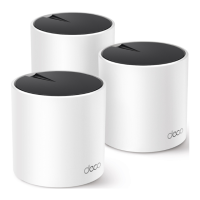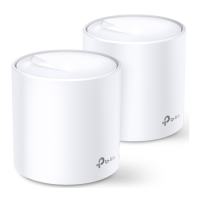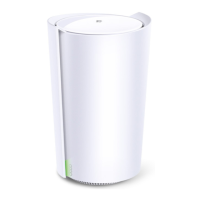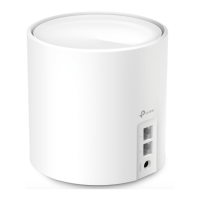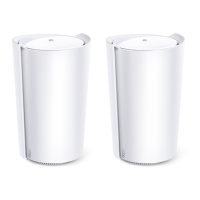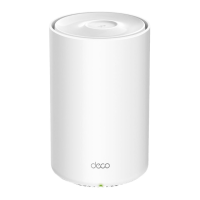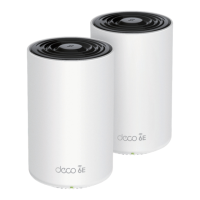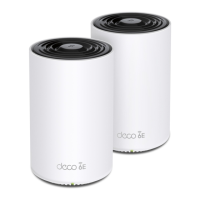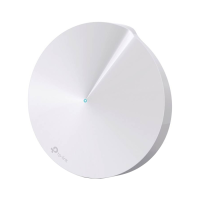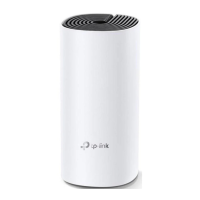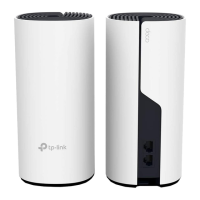Do you have a question about the TP-Link Deco X5400 Pro and is the answer not in the manual?
Explains terms, icons, and formatting used throughout the guide.
Covers speed, MU-MIMO, IoT compatibility, seamless roaming, and HomeShield limitations.
Explains the meaning of different LED colors on the Deco unit.
Details the Ethernet ports, power slot, and reset button on the Deco device.
Guide to downloading and installing the TP-Link Deco mobile application.
Steps for logging into your TP-Link account and identifying your Deco model.
Instructions for connecting the Deco to your modem and powering it on.
Choosing a location for the Deco and setting up the internet connection type.
Setting up your home Wi-Fi network name and password.
Completing the Deco setup and connecting your devices to the new network.
Viewing the current status of your network and connected devices.
Navigating to shortcuts, automation, HomeShield, and other app functionalities.
Steps to add additional Deco units to your existing mesh network.
Viewing the online/offline status of all Deco units in the network.
Accessing speed, IP, MAC address, and connected clients for each Deco.
Changing the assigned location or name for a specific Deco unit.
Viewing connected devices and enabling seamless roaming via Mesh.
Procedure for swapping the main Deco with a satellite unit without reconfiguring the network.
Steps to remove a Deco unit or reboot it for performance improvement.
Clarifies the difference between rebooting and removing a Deco unit's settings.
Accessing real-time connection details for each connected device.
Changing the name of a connected device for easier identification.
Setting up automated actions for connected devices based on triggers.
Prioritizing device connections and setting duration for enhanced performance.
Accessing and modifying various settings like device type, IP, MAC, and linked Deco.
Organizing devices into custom locations for efficient management.
Adding profiles to manage online activities, internet access, and content filtering.
Ensuring seamless roaming by enabling Mesh technology for devices.
Sorting devices into custom locations like 'Bed Room' for quick access.
Steps to create a new network using the Overview page in the Deco app.
Steps to create a new network using the app's menu option.
Procedure to change the network owner to another TP-Link ID.
Steps to delete a Deco network and reset all associated devices.
Adding and managing smart home devices through the Deco app.
Steps to create a shortcut for quick execution of actions.
Selecting the action type and the specific device for the shortcut.
Setting action duration, delay time, and turning devices on/off.
Naming the shortcut, selecting an icon, and executing the action.
Setting up automated interactions between devices using triggers and actions.
Choosing the type of trigger (e.g., lights, network devices) for automation.
Selecting the trigger device and defining its condition (e.g., connected).
Adding actions to be performed when the automation trigger is met.
Setting action parameters like turn on/off, duration, and delay for automation.
Naming the automation and confirming its setup for execution.
Introduction to TP-Link HomeShield for network protection and parental controls.
Explains Scan, Real-Time Protection, Parental Controls, QoS, and Reports.
Changing Wi-Fi name, password, and hiding the network SSID.
Methods for sharing your Wi-Fi network with others.
Setting up a separate Wi-Fi network for guests to maintain main network security.
Blocking specific devices from accessing your network.
Removing devices previously added to the deny list.
Procedure to update Deco firmware for improved performance and stability.
Modifying WAN settings and enabling IPv6 internet connections.
Adding firewall rules to control access to specific services.
Modifying LAN IP settings and configuring the DHCP server.
Enabling IPTV/VLAN mode and using MAC Clone for internet connectivity issues.
Assigning static IP addresses to specific devices for easier management.
Setting up port forwarding and registering a DDNS domain name.
Enabling SIP ALG for communication with SIP servers via NAT.
Enabling features for dynamic port opening, seamless roaming, and stronger Wi-Fi.
Managing Deco LED behavior, including a night mode for dimming.
Choosing between Wireless Router and Access Point modes.
Setting up alerts for device connections, disconnections, and other events.
Using Wi-Fi Protected Setup to quickly connect clients without a password.
Inviting friends or family to help manage the Deco network.
Setting specific privileges for network managers.
Defining access levels for network managers (e.g., client, IoT management).
Removing previously added managers from the network.
Setting up Alexa integration to control Deco features with voice commands.
FAQ addressing common problems during Deco setup and operation.
Statements regarding FCC compliance for the device.
Contact information for TP-Link USA Corporation.
Guidelines for safe operation, environment, and handling of the device.
Details the meaning of various symbols found on the product label.
Information on operating temperature, electromagnetic fields, and user safety.
Information regarding the selective sorting symbol for Waste Electrical and Electronic Equipment.
| Total Speed | 5400 Mbps |
|---|---|
| Memory | 512 MB |
| Flash Memory | 128 MB |
| MU-MIMO | Yes |
| OFDMA | Yes |
| Beamforming | Yes |
| Parental Controls | Yes |
| Guest Network | Yes |
| Quality of Service (QoS) | Yes |
| 5 GHz-1 Speed | 2402 Mbps |
| 2.4 GHz Speed | 574 Mbps |
| Ethernet Ports | 3 x Gigabit Ethernet |
| WAN Port | Yes (Supports WAN/LAN auto-sensing) |
| Security | WPA3 |
| Operating Temperature | 0°C to 40°C (32°F to 104°F) |
| Operating Humidity | 10% to 90% non-condensing |
| Storage Temperature | -40°C to 70°C (-40°F to 158°F) |
| Storage Humidity | 5% to 90% non-condensing |
| Power Supply | 12V/2A |
| Antenna Type | Internal |
